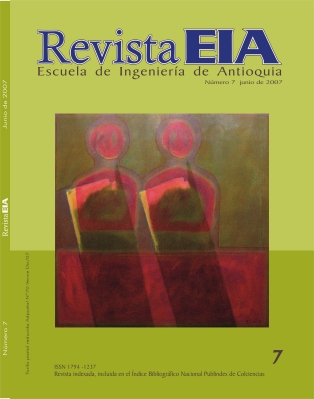INFLUENCIA DE LA FATIGA MUSCULAR EN LA SEÑAL ELECTROMIOGRÁFICA DE MÚSCULOS ESTIMULADOS ELÉCTRICAMENTE
INFLUENCIA DE LA FATIGA MUSCULAR EN LA SEÑAL ELECTROMIOGRÁFICA DE MÚSCULOS ESTIMULADOS ELÉCTRICAMENTE


This work is licensed under a Creative Commons Attribution-NonCommercial-NoDerivatives 4.0 International License.
Copyright statement
The authors exclusively assign to the Universidad EIA, with the power to assign to third parties, all the exploitation rights that derive from the works that are accepted for publication in the Revista EIA, as well as in any product derived from it and, in in particular, those of reproduction, distribution, public communication (including interactive making available) and transformation (including adaptation, modification and, where appropriate, translation), for all types of exploitation (by way of example and not limitation : in paper, electronic, online, computer or audiovisual format, as well as in any other format, even for promotional or advertising purposes and / or for the production of derivative products), for a worldwide territorial scope and for the entire duration of the rights provided for in the current published text of the Intellectual Property Law. This assignment will be made by the authors without the right to any type of remuneration or compensation.
Consequently, the author may not publish or disseminate the works that are selected for publication in the Revista EIA, neither totally nor partially, nor authorize their publication to third parties, without the prior express authorization, requested and granted in writing, from the Univeridad EIA.
Show authors biography
La estimulación eléctrica funcional es una técnica de rehabilitación para pacientes con parálisis, que restituye la función motora perdida, la cual puede estudiarse por medio del registro de la actividad eléctrica de los músculos o señal electromiográfica. Cuando el músculo está siendo estimulado, esta señal es una onda de despolarización sincronizada con el estímulo que recibe el nombre de onda M. Esta onda es el principal indicador de la respuesta del músculo al estímulo eléctrico y presenta cambios en sus características frecuenciales y morfológicas cuando aparece el fenómeno de fatiga. La fatiga muscular limita el uso de sistemas de estimulación funcional durante periodos prolongados. Las variables más usadas para evaluar los cambios ocurridos en la onda M son su amplitud y duración y la media y la mediana de su espectro de frecuencias. Durante el fenómeno de fatiga, la amplitud de la onda M disminuye y su duración aumenta. Como conscuencia de la acumulación de ácido láctico, se reduce la velocidad de conducción de las fibras musculares, evidenciándose esto en una compresión espectral y un corrimiento del espectro de frecuencias hacia las bajas frecuencias. Los trabajos reportados que estudian los cambios ocurridos en la onda M se limitan a condiciones estáticas. Es necesario, entonces, el desarrollo de nuevas técnicas que detecten la ocurrencia del fenómeno de fatiga en condiciones dinámicas similares a las existentes en la vida diaria.
Abstract: The functional electrical stimulation is a technique of rehabilitation for patients with paralysis that restitutes the lost motor function, which can be studied by means of the registry of the electrical activity of muscles or electromyographic signal. When the muscle is being stimulated, this signal is a wave of synchronous depolarization with the stimulus, which receives the name of M-wave. This wave is the main indicator of the answer of the muscle to the electrical stimulus and presents changes in its spectral and morphological characteristics when the fatigue phenomenon appears. The muscular fatigue limits the use of systems of functional stimulation during prolonged periods. The variables more used to evaluate the changes in M-wave are their amplitude and duration, and the mean and the median of their frequency spectrum. During the fatigue phenomenon, the amplitude of the M-wave diminishes and its duration increases. As a result of the lactic acid accumulation, the speed of conduction of muscular fibers is reduced, resulting in a spectral compression and a shift of the frequency spectrum towards the low frequencies. The reported works that study the changes in M-wave during the occurrence of the phenomenon of fatigue are limited to static conditions. It is then necessary the development of new techniques to detect the occurrence of the phenomenon of fatigue in dynamic conditions similar to those existing in the daily life.
Article visits 302 | PDF visits 185
